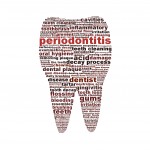
Periodontal disease is common, and the cornerstone of treatment is scaling and root planning. Adjuncts to scaling and root planning have included systemic and local antibiotics and antiseptics. With increasing concerns regarding antibiotic resistance greater use of antiseptics may be a possibility.
The aim of this review was to assess the effectiveness of adjunctive local antiseptics to conventional scaling and root planning (SRP)
Methods
Searches were conducted in the Medline and Cochrane Central Register of Controlled Trials (CENTRAL) databases supplemented by hand searches in the journals; International Journal of Periodontics and Restorative Dentistry, Journal of Clinical Periodontology, Journal of Periodontology, and Journal of Periodontal Research. Randomised controlled clinical trials (RCTs) comparing the effectiveness of one or more antiseptic agents as adjuncts to scaling and root planning (SRP) were considered. Only English language papers published since January 2000 and of more than 6-months duration were included.
Two reviewers independently selected studies for inclusion. Data was extracted and quality assessed using the Cochrane risk of bias tool. The primary outcome was change in pocket-probing depths (PD) with changes in clinical attachment level (CAL) and/or bleeding on probing (BOP) as secondary outcomes. A random effects meta-analysis was conducted.
Results
- 12 RCTs (6 split mouth studies) involving 632 patients were included.
- 3 studies were considered to be at low risk of bias, 5 at moderate risk and 4 at high risk.
- 9 studies involved use of adjunctive sustained-release antiseptics, gels, chips, or varnish with 3 using adjunctive irrigation.
- Compared to SRP alone SRP with adjunctive antiseptics showed statistically significant changes for the PD and CL. Similar findings were seen when for the 9 studies using sustained release agents but not for the 3 studies involving irrigant antiseptics
| Number of studies | Probing Depth (95%CI) | Clinical Attachment level (95%CI) | |
| All adjunctive antiseptics | 12 | 1.536 (0.402 – 2.670) | 1.515 (0.289 – 2.741) |
| Sustained-release antiseptics | 9 | 1.977(0.470 – 3.485) | 2.174 (0.438 – 3.909) |
| Irrigant antiseptics | 3 | 0.460 (-0.546 – 1.467) | 0.017(-0.292 – 0.326) |
Conclusions
The authors concluded: –
…. adjunctive subgingivally delivered antiseptics with a sustained-release delivery have significant clinical benefits compared to SRP alone. Furthermore, future studies should be based on adequate methodological procedures to improve the overall quality of the reporting and to reduce the risk of bias.
Comments
The search strategy for this review has been restricted to studies published since 2000 and those published in English. In addition, only two major databases have been searched so while this have been supplemented with searches of a number of major databases there is a high likelihood that relevant studies will have been excluded. 12 studies have been included in the review half of which are split mouth studies and although the interventions used are locally delivered there is a concern regarding the potential for cross-over effects. In addition, only a 25% of the included studies were considered to be at low risk of bias.
The way in which the figures reporting the results in the paper is confusing as standardised mean differences (SMD) are presented for CAL and PD and odds ratios (OR) for bleeding on probing yet all the figures are labelled as forest plots of odds ratios! The results suggest that adjunctive antiseptics improve the outcomes for CAL and PD and that potentially the sustained release agents work better. However, the review is unlikely to have identified all the relevant studies and quality of the included studies is low. Consequently, the findings should be interpreted cautiously and additional high quality well reported RCTs with appropriate sample sizes are needed to provide better quality information on the effectiveness of SRP and adjunctive antiseptics.
Links
Primary Paper
Ramanauskaite E, Machiulskiene V. Antiseptics as adjuncts to scaling and root planing in the treatment of periodontitis: a systematic literature review. BMC Oral Health. 2020;20(1):143. Published 2020 May 18. doi:10.1186/s12903-020-01127-1
Other references
Dental Elf – 7th Feb 2020
Chlorhexidine gel as an adjunct to non-surgical periodontal treatment
Dental Elf – 9th Aug 2017
